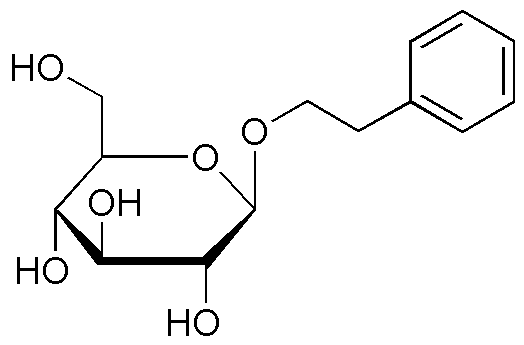Phenylethyl-b-D-glucopyranoside is widely utilized in research focused on:
- Pharmaceutical Development: This compound is studied for its potential therapeutic effects, particularly in the development of drugs targeting metabolic disorders and diabetes.
- Food Industry: It serves as a natural sweetener and flavor enhancer, providing a healthier alternative to synthetic sweeteners in food products.
- Cosmetic Formulations: Its moisturizing properties make it a valuable ingredient in skincare products, helping to improve hydration and skin texture.
- Biochemical Research: Researchers use it to investigate cellular signaling pathways, particularly those related to glucose metabolism and insulin sensitivity.
- Natural Product Synthesis: It is employed in the synthesis of other bioactive compounds, contributing to the discovery of new drugs and therapeutic agents.
General Information
Properties
Safety and Regulations
Applications
Phenylethyl-b-D-glucopyranoside is widely utilized in research focused on:
- Pharmaceutical Development: This compound is studied for its potential therapeutic effects, particularly in the development of drugs targeting metabolic disorders and diabetes.
- Food Industry: It serves as a natural sweetener and flavor enhancer, providing a healthier alternative to synthetic sweeteners in food products.
- Cosmetic Formulations: Its moisturizing properties make it a valuable ingredient in skincare products, helping to improve hydration and skin texture.
- Biochemical Research: Researchers use it to investigate cellular signaling pathways, particularly those related to glucose metabolism and insulin sensitivity.
- Natural Product Synthesis: It is employed in the synthesis of other bioactive compounds, contributing to the discovery of new drugs and therapeutic agents.
Documents
Safety Data Sheets (SDS)
The SDS provides comprehensive safety information on handling, storage, and disposal of the product.
Product Specification (PS)
The PS provides a comprehensive breakdown of the product’s properties, including chemical composition, physical state, purity, and storage requirements. It also details acceptable quality ranges and the product's intended applications.
Certificates of Analysis (COA)
Search for Certificates of Analysis (COA) by entering the products Lot Number. Lot and Batch Numbers can be found on a product’s label following the words ‘Lot’ or ‘Batch’.
*Catalog Number
*Lot Number
Certificates Of Origin (COO)
This COO confirms the country where the product was manufactured, and also details the materials and components used in it and whether it is derived from natural, synthetic, or other specific sources. This certificate may be required for customs, trade, and regulatory compliance.
*Catalog Number
*Lot Number
Safety Data Sheets (SDS)
The SDS provides comprehensive safety information on handling, storage, and disposal of the product.
DownloadProduct Specification (PS)
The PS provides a comprehensive breakdown of the product’s properties, including chemical composition, physical state, purity, and storage requirements. It also details acceptable quality ranges and the product's intended applications.
DownloadCertificates of Analysis (COA)
Search for Certificates of Analysis (COA) by entering the products Lot Number. Lot and Batch Numbers can be found on a product’s label following the words ‘Lot’ or ‘Batch’.
*Catalog Number
*Lot Number
Certificates Of Origin (COO)
This COO confirms the country where the product was manufactured, and also details the materials and components used in it and whether it is derived from natural, synthetic, or other specific sources. This certificate may be required for customs, trade, and regulatory compliance.


